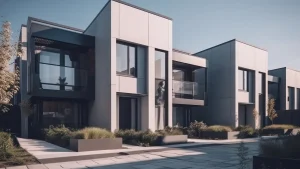Urbanisation is a global phenomenon that is expected to continue for the foreseeable future. As cities continue to grow, so does the need for innovative urban design solutions that can address the challenges of population growth, climate change, and resource depletion. Smart cities and sustainable communities are two emerging trends in urban design that offer promising solutions for these challenges.
In this post, we will explore what smart cities and sustainable communities are, and how they can help shape the future of urban design.
What are Smart Cities?
Smart cities are cities that use advanced technology to improve the quality of life for their residents. This includes using sensors, data analysis, and other technologies to improve transportation, energy consumption, waste management, and public safety.
One example of a smart city is Singapore, which has implemented a number of smart city technologies, such as a network of sensors that monitor everything from traffic to air quality. This has allowed the city to optimise its transportation systems, reduce energy consumption, and improve public safety.
What are Sustainable Communities?
Sustainable communities are communities that are designed to be environmentally, socially, and economically sustainable. This includes designing buildings and infrastructure that minimize resource consumption and waste, promoting walkability and access to public transportation, and fostering a sense of community and social connection.
One example of a sustainable community is the BedZED (Beddington Zero Energy Development) in London, which is a carbon-neutral development that includes energy-efficient homes, renewable energy sources, and sustainable transportation options.
How do Smart Cities and Sustainable Communities Work Together?
While smart cities and sustainable communities have different focuses, they are both part of a broader trend towards urban design that is focused on creating livable, sustainable cities. By incorporating smart city technologies into sustainable communities, it is possible to create cities that are both technologically advanced and environmentally sustainable.
For example, a sustainable community might include energy-efficient buildings, public transportation, and green spaces, while also incorporating smart city technologies such as sensors to monitor energy consumption and traffic flow.
Benefits of Smart Cities and Sustainable Communities
There are many benefits to creating smart cities and sustainable communities, including:
- Improved Quality of Life: By creating cities that are more efficient and sustainable, it is possible to improve the quality of life for residents, with benefits such as cleaner air, better transportation options, and greater access to green space.
- Reduced Resource Consumption: By minimising resource consumption and waste, smart cities and sustainable communities can help reduce the impact of urbanisation on the environment.
- Economic Development: Smart cities and sustainable communities can also drive economic development by creating jobs in industries such as technology and renewable energy.
- Improved Public Safety: By using smart city technologies to monitor and respond to potential safety hazards, it is possible to create cities that are safer and more secure for residents.
Conclusion
Smart cities and sustainable communities offer promising solutions for the challenges of urbanisation. By incorporating advanced technologies and sustainable design principles, it is possible to create cities that are more liveable, sustainable, and resilient. As urbanisation continues to accelerate, it is essential that we continue to explore innovative urban design solutions that can help us create the cities of the future.







